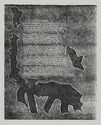
19th, 20th & 21st Century Fine Prints
707-546-7352 · fax 707-546-7924 · web: www.annexgalleries.com · email: artannex@aol.com
Yves Tanguy Biography
Yves Tanguy
French
1900–1955
Biography
Raymond Georges Yves Tanguy was born on January 5, 1900 at the Ministry of Naval Affairs on Place de la Concorde in Paris, France. His father, a retired sea captain, was an administrative official there. After his father died in 1908, Tanguy's mother moved back to her native Locronan, Finistère, Brittany. Tanguy spent much of his youth there, living with various relatives. In 1918, Tanguy shipped out on merchant vessels headed for Africa and South America. In 1920 he was drafted into the French Army and attached to an infantry regiment stationed at Lunéville. While stationed there he met Jacques Prévert, poet, screenwriter, and fellow Breton. Prévert would become one of Tanguy's closest friends during his early years as an artist. Tanguy's military service ended in 1922, and he returned to Paris. He was reunited with Prévert there and together they survived with limited means. He started sketching on scraps of paper, tablecloths, and napkins in cafés and attracted the attention of the artist Maurice Vlaminck, giving Tanguy the idea of being an artist. While riding on a bus one day in 1923, Tanguy saw an early work by Giorgio de Chirico in the window of the gallery of Paul Guillaume. The piece made such an impression on Tanguy that he decided that he would be an artist.
In a very small studio, and with a complete lack of formal training, Tanguy began his career. In and around 1924, through his friend Jacques Prévert, Tanguy was introduced to André Breton and the circle of surrealist artists. Subsequently, in 1926, one of Tanguy's works was reproduced in the magazine La Révolution Surréaliste, and he was recognized as a surrealist. Tanguy's unique style developed quickly and in 1927 he had his first solo exhibition in Paris. During this time he met his first wife, and Breton contracted Tanguy to paint 12 pieces a year but with a fixed income he painted less and only created eight works.
In 1929, Tanguy met Stanley William Hayter and began working in Hayter's printmaking workshop Atelier 17 in Paris, with Joan Miró, Hans Arp, Max Ernst, Alberto Giacometti, Pablo Picasso, and others. In 1930, at an early screening of Buñuel and Dalí's L'Age d'Or, the right-wing group Ligue des Patriotes, after throwing ink at the screen and assaulting opposition from viewers, entered the lobby of the theater where the film was being shown, and destroyed works by Tanguy, Joan Miró, Man Ray, Dalí, and others.
In 1938, Tanguy went to London to hang his first retrospective exhibition in Britain at the Guggenheim Jeune gallery. The exhibition was a great success and Tanguy made a good living from it. That same year Tanguy met fellow artist Kay Sage who he would later marry. With the outbreak of World War II, Sage returned to her native New York, and Tanguy followed. Sage and Tanguy were married on August 17, 1940 in Reno, Nevada. Toward the end of the war, they moved to Woodbury, Connecticut and converted an old farmhouse into an artists' studio. They spent the rest of their lives there, and in 1948 Tanguy became a naturalized U.S. citizen.
Yves Tanguy died on January 15, 1955 at the age of 55.

